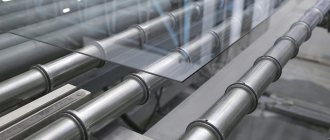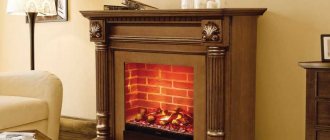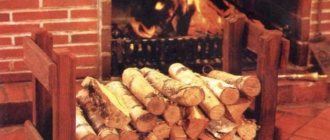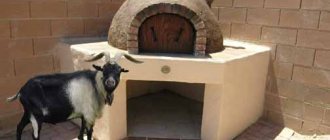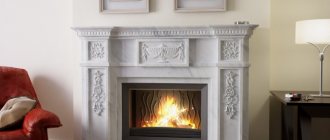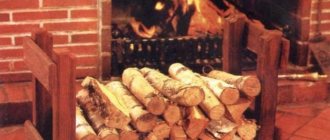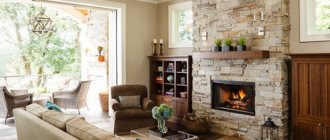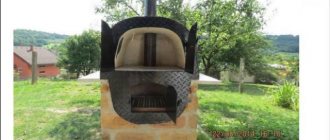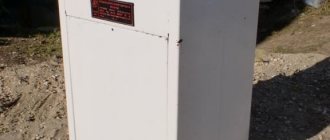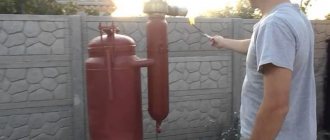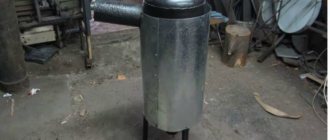Preparation, list of tools
Before starting work, you need to determine and mark the place that the new stove will occupy.
The chimney pipe should be no closer than 15 cm from the roof rafters.
If you are doing masonry for the first time, professional stove makers advise you to practice in advance by making a model of the future stove from prepared bricks. Naturally, without a solution. This minimizes possible risks during real masonry, allowing you to learn from your mistakes, which can still be corrected in the layout.
The stove foundation requires preliminary waterproofing; its area must exceed the area of the stove.
When laying a new row, you need to control the absolute verticality of the walls.
To build a brick kiln, the following tools are needed:
- plumb line;
- trowel;
- roulette;
- putty knife;
- Bulgarian;
- knitting wire;
- building level;
- metal strips, corners;
- containers for cement and clay mortar.
Door selection
The first thing to consider when choosing a door for a brick oven is the heating temperature that will occur in the firebox. Due to the increase in temperature, the product will expand. Other factors must also be taken into account
There is an important rule for choosing oven doors
The gap between the door and the oven wall should be minimal. It is filled with basalt wool or asbestos. In addition, it is worth considering some recommendations from professional stove makers:
- To look at the flame, you should buy cast iron products with glass inserts. However, you should prepare for the fact that the product will be expensive.
- For heating appliances using coal or mixed fuel, cast iron products should be chosen. If the stove is heated with wood, you can use glass or steel.
- To increase safety, it is better to purchase a metal structure that has a heat shield. In this case, the maximum temperature of the outer surface of the door will heat up to 40 degrees.
- To prevent cracks from appearing in the glass, when installing a door with a seal, you can leave a small space between the product and the walls. This will prevent cracks from appearing even with severe overheating.
These tips will help you install a door in any oven.
Door specifics
If you intend to make a door with glass inserts, you should first of all decide on its style
It is important that it matches the overall decoration of the room and the specifics in your particular case. So, for example, in small rooms it makes sense to make a double-leaf insert or a rising one to save space.
Both of these options are ideal for a corner fireplace. The main point that should not be forgotten is the selection of glass. It must have a heat resistance of at least 800 degrees - it is to this temperature that the flame usually flares up.
The prepared glass is inserted into the metal frame of the door itself, and that, in turn, is attached with hinges to the outer frame, which is fixedly fixed in the opening of the firebox. Wherein:
- a seal is installed on the inside to prevent smoke from entering the room;
- At the bottom of the outer frame, holes are made with adjustable plugs for air access to the firebox;
- Keep in mind that metal tends to expand greatly when heated, so the gap between the transparent insert and the frame is not made too large;
- When starting production, remember that the glass cannot be fixed tightly, because during installation it will need to be removed from the door;
- strips of fiberglass are inserted into the frame to seal it.
Characteristics
The designs of all stoves, unlike most fireplaces, require the mandatory closing of the hearth. The furnace door for the stove has several functions:
- protects the room from open fire;
- ensures heat transfer from burning fuel to rooms;
- prevents sparks from entering the room;
- increases the efficiency of the combustion process;
- decorates the structure as a whole.
All elements of furnaces must be fire-resistant, mechanically strong, and prevent the occurrence of fires.
Conventional doors for the combustion chamber allow air to pass through because they are not sealed tightly with a regular handle. Compacted types have a clamping mechanism, which reduces the amount of air entering the interior.
An eye-pleasing feature of some doors is a glass insert mounted in the center; it does not perform any important functions, but it makes it possible to enjoy the sight of a burning fireplace, which many owners really like.
Material
Metal (often stainless steel or cast iron) is used as the basis for the fire door for a stove with glass. According to the characteristics of experienced craftsmen, cast iron is more preferable: it is distinguished by durability, it is not afraid of high temperatures, it is easy to clean, and it is quite durable. Stainless steel will become very hot when the stove is fired; it is not intended for open fire and will soon warp.
From glass
Glass doors are available in single or double door versions. One oven door usually has a large window to view the fire. There is no difference in functionality. A lot depends on taste here. In two-door ovens, the design is close to ancient forms. It is possible to look at the fire through 1 large glass or 2 small ones. Much will depend on the preferences of buyers and the interior of the room. Advantages of a stove door with glass:
- Glass can withstand the influence of elevated temperatures for a long period of time - this positively distinguishes it from devices made of steel. It is superior in fire resistance to cast iron.
- Fireproof special glass for stoves and fireplaces is approximately 0.4 cm thick and can withstand temperatures up to 2000 degrees.
- Compact dimensions and low weight.
- The main advantage of a glass oven door is the ability to look at the flame. Such an option will outweigh any disadvantages, forcing stove users to purchase stove doors made of a similar material, despite the short period of use and high price compared to solid metal doors.
Flaws:
- The creation of glass doors for a furnace is considered to be a more labor-intensive process than production from a solid sheet. To avoid cracks during use, a little space is left when installing with a seal. The doors will trap sparks from the fire, preventing them from entering the room. Glass inserts are designed so that air blows over the material, preventing soot from lingering on it. Otherwise, the glass will be smoked.
- Fragility of the material. Fire-resistant glass sometimes cracks with minor impacts.
- The price of a device with glass inserts is higher than one made of solid material.
- Glass door ovens are much less efficient than cast iron ovens because heat dissipates through the glass. The larger the material, the less efficient the stove is at heating the room.
Important! Often a stove door with glass is combined with a metal device. In such situations, the frame is made of steel and the door is made of glass.
We suggest you familiarize yourself with How to properly make a blind area around the house
This category involves doors made entirely of metal. The installation process is quite simple and does not have any complications. The products retain heat well and are distinguished by increased fire safety. When the need arises, it is possible to make them yourself with minimal expense. Key advantages of metal products:
- Reasonable price. Compared to a stage on a glass device, it is much smaller, which is why it has a certain prevalence.
- Durability and reliability of such devices. With proper care (regular anti-corrosion treatment using paints that are classified as fire-resistant), they will last a long period of time without causing discomfort to the user.
Important! Despite the fact that such doors have their own consumer, the market demand is quite low, since they do not provide the opportunity to look into the flame.
Cast iron door
Cast iron doors, which are heat resistant, are considered the best for brick stoves. When parts made of steel deform over time due to temperature, those made of cast iron can last for decades. In the place of combustion, the temperature will reach 800 degrees, and for steel the working temperature will be 600.
Main advantages:
- Excellent interaction with elevated temperatures.
- Durability and reliability. The cast iron fireplace vent door can withstand any load.
- Beautiful models can be easily created from cast iron.
All this optimally finds its own application in this area; many firebox doors are made directly from cast iron.
Types of fire doors
Today, all doors used in ovens can be divided into several groups, which differ in certain ways. For example, such products are made from a variety of materials:
- One of the most common materials for fire doors is cast iron. Such products have been quite popular for many decades. However, they have such disadvantages as large mass, inconvenience of use, and a significant volume of products.
- The second group includes iron doors. Typically, such products are used when arranging stoves in baths. Iron doors are not used for home stoves because they have a relatively small number of positive characteristics.
- Furnace doors are also made of panoramic glass. Today, such models are most widespread. They are quite light and also provide a full overview of the combustion space.
The last option for the oven door is worth paying special attention to. Their advantages and disadvantages should be described, as well as the types of similar products should be highlighted.
Self-production of forged doors
Real forging is very expensive, so you can use its imitation. But since the structure will not be so strong, it should be created on the basis of a frame. For this, two corners are used. The frame will not be solid, but only representing the lower part of the door and the part to which the hinges will be attached.
Forged doors are usually made as double hinged doors. Forging elements are welded onto the created frame. The main thing is that they are identical in pairs on two doors. Such fireplace doors will not stop flying embers, and this should be constantly remembered.
Stages of work
The first thing to do is cut out the corner. And then give the desired shape to the structure. In order to carry out this operation, you need to lay the corner on a flat surface, check the correctness of all connections, and then weld all the necessary parts. After finishing the work, you need to inspect the door again for correctness and compliance with the form.
Then you need to mark the inner contour of the frame on a sheet of metal. After finishing the markings and receiving all the measurements, you need to increase them slightly and leave a small allowance on each side. Taking these marks into account, it is necessary to cut out the part using a metal grinder. Since the door is planned with glass, it is necessary to have a piece of heat-resistant material that will be mounted.
Using the same tool, glass is cut to the required dimensions. Next, you need to weld the curtains to the frame. After this, you need to grab them to the common door frame. When this operation is completed, you need to make sure that nothing interferes with the opening and closing of the door. If this condition is met, then final welding can begin. The door handle is attached last.
Step-by-step instructions with photos for laying a stove
Different stove makers have their own masonry technologies and their own secrets that come with years of experience. Here is information about a fairly simple way to create a stove-fireplace for heating a two-story house; the process will not seem extremely difficult even to novice stove makers.
Foundation laying
The base course of brickwork will serve as the foundation. It is done with any brick; some stove makers even fill this level with crushed stone.
When laying the base row, cement mortar is used.
The foundation is completely filled with mortar, the layer is leveled.
Construction of the furnace body
The first row of stoves is marked. The horizontal line from which they start when marking is the wall of the room.
A grate is placed where the fireplace is planned to be placed. From this row, the bricks are already laid on the kiln mortar.
An important stage of work is the scrupulous alignment of each new row by level.
Laying the second row. The stove wall, located closest to the wall of the room, is reinforced with additional bricks to increase fire safety.
The place where the chimney will be located in the 2nd row remains empty, the rest of the stove is laid completely. A door is installed through which the owners will clean out the ash.
The door is installed on the solution and leveled. For a more reliable fixation, it is secured with wire, which must be laid between the bricks.
Next, the next 3 rows are placed. Then a brick stop for the grate is installed - 2 rows of 1/4 bricks are placed on the sides.
The grate is laid not on a simple brick, but on a refractory brick. To ensure that it lies at the same level as the bricks, holes are cut in the fireclay bricks.
The size of the brick can be easily adjusted - the excess is measured and carefully cut off.
The large door is mounted next to the installed grille.
The large oven door is similarly secured using wire fasteners.
The first row of fireboxes is placed exactly above the fireplace, it is reinforced with metal corners and a strip or thick tin. So that the masonry can lie on them, it is cut using a grinder, then the slots are adjusted manually to the desired size.
The next brick row is laid.
A fireplace grate is laid on the fire-resistant brick along with the brick row.
The door is fixed, the brick is strictly adjusted to it.
The firebox of the new stove and fireplace is ready.
Fire-resistant fireclay bricks are placed above the stove firebox.
The stove body is built.
Creating a chimney
The space left for the chimney is divided into wells. The design requires reinforcement with metal plates.
Brick chimney wells are laid.
Soot cleaners are mounted above the firebox roof.
The wells are divided again, the first rows of walls should be reinforced with strips of metal.
After strengthening, the ceiling of the furnace body is erected. The space associated with the chimney remains empty.
The body cornice is laid out, then the chimneys are laid.
The final stage of work on the first floor. The stove is located at the bottom left, the smoke inside the chimneys moves in a spiral and comes out at the top left. The final separation of the wells is covered with a tin sheet. In order to compensate for the pressure inside the fireplace stove, 2 brick rows are laid on the tin.
There are two chimneys stretching to the second floor of the house - from the fireplace and the stove itself, they are separated from each other. Each chimney requires the installation of a separate damper.
Floor level of the second floor. Waterproofing is installed here, the chimney is again reinforced with metal corners. To save money and avoid building a heating stove on the second floor, the chimney of the stove under construction is again divided. The smoke will snake through it, managing to warm up the room. In order for the chimney to warm up much faster, it is laid in the area of the second floor with a thickness of 1/4 or 1/2 brick.
A hole for the stove chimney is carefully cut out in the roof.
Before placing the chimney on the roof, it is reinforced with metal corners.
If the chimney is located in close proximity to the roof ridge, it must be laid out at least 0.5 meters above the ridge. If further, then the height of the chimney is allowed equal to the height of the ridge, but not lower. In this case, the wind increases the stove draft, lifting the smoke upward.
Even a small stove in the house means coziness and comfort. Larger stoves require increased skill and additional materials, but the principle of their construction is similar to the method described above.
rmnt.ru
19.02.17
How to fold a stove firebox with your own hands
The furnace firebox consists of a ashpit (ash pan) with a door, a grate and a combustion chamber (firebox) with a door.
Dimensions are determined based on the volume of firewood for simultaneous loading. The width of the combustion chamber is equal to its door or slightly wider on both sides.
The height of the firebox should facilitate complete combustion of fuel, which is achieved by having free space in the chamber after loading firewood. Recommended height 80-100 cm.
Reference. The depth of the furnace firebox must accommodate the length of the combustible material; there are no other restrictions.
The combustion chamber is connected to the ash pan via a grate. The latter is designed to supply air during combustion and collect ash. When installing the grate, it must be buried below the level of the fire door to prevent burning coals from falling onto the floor.
The firebox must have bevels in the direction of the grate to move the ash into the ash pit. The gap between the masonry and the grate must be at least 5 mm to prevent rupture of the brick as a result of the difference in expansion of the brick material and metal at high temperatures.
The choice of materials for masonry and flooring, how to process the structure
The structure is made of clay red brick with lining (lining) of fire-resistant material
When choosing a brick material, you need to pay attention to ensure that it is not burnt or cracked. High-quality brick, suitable for stove masonry, has smooth edges, sharp edges and a uniform color; when tapped, a clear, almost metallic sound is heard
Attention! Sand-lime brick is not suitable for the construction of the device. The following materials will be required:
The following materials will be required:
- red brick - for walls;
- refractory and wedge-shaped (fireclay) bricks - for lining and forming the ceiling;
Photo 1. Refractory brick used for laying the furnace firebox. Before using the material, you must ensure its integrity.
- clay, sand, water - for solution;
- cast iron grate;
- doors of the combustion chamber and ash pan;
- steel strips or wires - for fastening doors;
- asbestos sheet - for a fireproof gasket between the masonry and the doors.
To connect the stove masonry, you can buy a ready-made mixture or prepare the solution yourself. In high-temperature zones, compositions made exclusively of red clay, sand and clean water are used. The quality of the solution depends on the viscosity, plasticity and fat content of the clay. Sand for construction must be free of dirt and impurities.
Preparing tools
The necessary set of tools will allow you to make a structure with your own hands:
furnace hammer;
- trowel - for applying the solution;
- large container - for preparing the solution;
- building level - to control the correctness of the masonry;
- measuring instruments - ruler, tape measure, square;
- plumb lines - to determine the outer contour.
How to properly cover the firebox and make a roof for a brick oven
To build a firebox, the exact layout of the future furnace must be determined and a foundation with a layer of waterproofing must be laid.
Before laying on the mortar, you need to assemble the structure without it - to accurately adjust the bricks to size.
The phased construction looks like this:
- Prepare a solution.
- The first row is laid on the foundation without gaps and formed under the stoves.
- On the second row, the formation of the ash pan and the fastening of its door begin. To do this, mark the center of the future firebox and place the blower strictly under it. A flexible wire is passed through the holes in the door frame and its ends are twisted into a bundle. Wire bundles are fixed in the masonry layer.
- The contour of the blower and the location for laying the grate are formed.
- Secure the combustion door with wire. The door frame is insulated with a gasket made of non-combustible material.
- The walls of the firebox and the vault with a hole for connecting the chimney are formed.
- The combustion chamber is lined with refractory bricks.
Important! During construction, you cannot combine simple bricks and refractory bricks due to different expansion coefficients. When heated, such masonry will burst
Heat-resistant glass
So, we have found that in most cases, consumers prefer to install doors for fireplaces and stoves made of heat-resistant glass (the exception is those appliances that consume coal or mixed fuel). What is the secret of popularity? First of all, the fact that today the production of such glasses has noticeably improved and become more complex. The production process consists of several stages, such as:
- heat treatment;
- treatment with chemicals;
- polishing at high temperature.
Using special glass melting furnaces, manufacturers obtain sheets of material of the required thickness, and their surfaces are treated with special preparations that increase not only fire resistance and strength, but also the service life of the finished products.
After completing all technological stages, the finished fireplace glass acquires a lot of unique positive qualities, including:
- resistance to high temperatures;
- low warm-up rate;
- aesthetic and, so to speak, noble appearance;
- excellent noise absorption;
- ability to withstand significant temperature changes due to low thermal expansion;
- In addition, no visible defects, not even the smallest cracks, appear on the surface of the glass.
Moreover, today, unlike several years ago, heat-resistant glass is produced with crystal and corrugated surfaces, as well as tinted ones (in the latter case, the bright flashes of fire are somewhat muffled).
We have already mentioned above about glasses that can independently remove soot that appears on the surface. Such glasses are called self-cleaning and are distinguished by the fact that they are coated with an almost invisible ball of metal oxide. Due to this, the inner surface of the glass heats up to a higher temperature when fuel burns, and the soot, as a result, burns out almost completely.
How to care for fireplace doors?
We have already noted that metal doors for stoves and fireplaces do not require special care - you just need to paint them with heat-resistant paint. With glass models everything is somewhat more complicated. For example, even self-cleaning models must be periodically cleaned of accumulated soot. This procedure requires a damp cloth and detergent (the same “Mr. Muscle”), but without abrasive components and chlorine. This way you will not damage the glass and the protective layer.
What affects the frequency of cleaning? First of all, this is the type of firewood used (how much resin it contains) and the pulling strength.
This is interesting: Fittings for sliding interior doors
Installation methods: choose any!
Check how easily the door opens and closes. If the part is new and tight, it needs to be developed before installation.
There are several ways to “embed” a part into the masonry: on a corner, using a stainless steel box, etc. Let's describe the most popular ones.
Installation of the combustion door on a wire
Experienced stove makers recommend using nichrome wire
, since this grade of steel has both ductility and good heat resistance. It will serve you faithfully for several decades.
You need to attach a wire to the frame of the combustion door, the diameter of which is 2-3 times less than the thickness of the joints in the brickwork. Usually the doors already have special holes for the wire, so this installation stage will not cause difficulties. But if there are no ready-made holes, it doesn’t matter. Drilling holes in a cast iron product is easy; with glass you will have to tinker more.
Installation on elements made of stainless steel sheets
These methods are more progressive. Stainless steel mounting elements are either flanged plates or a solid shell.
A thermally insulating non-combustible material, for example, silica fiber, must be placed between the stainless steel and the masonry. This is both protection against high temperatures and provision of damping for linear repetitive expansion of metal products during intense heating.
Flanged plates hold the part, clinging to the brickwork. Moreover, these plates must be installed on self-tapping screws, and the holes must be drilled in advance.
The one-piece shell is placed on the combustion door frame. The thickness of the metal sheet in this case should be less than when using plates.
Installing the door with self-tapping screws or bolts
A rather dubious option in terms of reliability for installing cast iron, metal and glass parts for the firebox.
Do not place the product tightly in the masonry under any circumstances.
You should also avoid sealing cracks with a solution of clay and sand. The part heats up quickly and strongly, which means that when it expands it can cause cracking of the brick and destroy masonry joints.
For clarity, we have prepared a video that will help you understand how to correctly install this firebox element.
What it is?
Hidden under the name “furnace doors for stoves” is a well-known element of fireplace design. Do not forget that, first of all, it, of course, performs utilitarian functions, but the overall appearance of your fireplace, and with it the atmosphere in the room, also depends on it. Fire doors for furnaces simultaneously serve:
- a barrier so that the fire burns better;
- a guarantee of safety so that not a single spark penetrates into the room;
- decorating a stove or fireplace.
Therefore, the choice of such a door should be approached with special care. And in our store you will find everything you need for this, thanks to our wide catalog.
What types of doors are there?
It is necessary to distinguish between two types of doors, which are used in heating devices and are widely represented in our catalog.
- Doors for stoves - as a rule, are a cast iron plate, uniform or richly decorated with patterns, which reliably protects the space surrounding the stove from sparks and ash.
- Fireplace doors are a more complex and elegant device, created from a cast iron frame and a special type of glass that is resistant to temperature changes, through which you can clearly see everything that happens to the flame inside.
What is the best way to buy a door?
The most convenient way for any buyer will be to purchase a door for fireplaces in the “Stoves Here” store. Here you will find:
- qualified consultants who are always happy to help you with your choice;
- convenient terms of delivery and payment for goods;
- a simple order form, filling out which will not take you much time;
- favorable prices accessible to everyone;
- An excellent selection of products for stoves and fireplaces for every taste.
Despite their simplicity, stove doors contain several elements, each of which performs a specific task.
In the first place is the door itself, which is designed to open and close the oven, ensuring safety during operation. There are several versions of these parts, for which different materials are used.
The most popular is the design with heat-resistant glass, metal and cast iron. Depending on what material is taken as a basis, the product acquires certain properties and characteristics.
During the production of equipment, special attention is paid to the elements located on the front side of the furnace, because the operation of the main equipment, as well as the design of the room, depends on their configuration
Glass door installation
Before installing a door with glass in the stove, you should check its ease of opening. If the part moves tightly, it should be developed. This will allow you to use the door as conveniently as possible in the future.
Usually in small heating appliances the temperature does not rise high enough. In addition, the frame is not exposed to open flame. For this reason, expansion of standard furnaces is minimal. Even when a piece of wire is exposed near the door, the wire itself holds in place very tightly.
There is an effective way to fasten the fire door, which prevents it from falling out. It is necessary to rivet special metal plates to it from the bottom and top. It is better to choose products with flared edges. Once all the steps are completed, the plates should be pressed into the brick.
Installation of the combustion door is carried out in stages:
- First, lay the grate.
- After this, plates and wire are attached to the door. As soon as the preparations are completed, the product is installed on the solution.
- Afterwards, the wire and plates are placed on the inner walls of the combustion chamber.
- The other ends of the metal elements are placed on 2 bricks, pressing on top with one brick.
The door angle is checked with a plumb line. Then the last wire is inserted into the door hole. It must be twisted tightly enough so that rings do not form. The wire is then placed in a hole in the first rib of the brick. Then it is pressed on top of the mortar with a brick.
Oven
The oven is usually made of strong steel. The gaps are determined using a level; the frame is wrapped in sheet asbestos, half a brick wide. The plane of the frame at the top must coincide with the masonry surface of the last row of bricks, therefore, if necessary, the asbestos layer must be increased.
The grate must be installed 25-30 cm below the combustion opening with a slope towards the combustion door. The bottom of the firebox is shaped like a trough, and the slots located between the grates should be along the firebox.
To prevent the grate from destroying the masonry when heated, it is necessary to leave 5 mm gaps, which are then covered with sand. The grate cannot be secured using the solution!
The blower door and, together with it, the cleaning door are installed in the same way as the firebox door. The blower door is practically not exposed to high temperatures, so it must be tightly and firmly walled into the stove masonry, treating the seams with clay mortar. The horizontal of the frame is also determined using a level.
Options for installing a stove in the house
The placement of the stove depends entirely on what exactly the owners expect from it. If it is installed in a small house and will be used as a fireplace for friendly gatherings, you can use the first scheme. This stove is a good option for cooking barbecue on the grill or kebabs.
Brick kiln placement options
The second scheme is for a house of solid square footage. In this case, the front side of the fireplace stove opens into the living room, the stove walls heat both bedrooms, and the heat in the remaining rooms is maintained using heat exchange.
The third scheme with a stove for heating and cooking is a budget housing option for a bachelor or a small family. Pros: a warm bed and the ability to place a dryer in the hallway.
Important: you should take care of the external insulation of the house in advance, because it greatly increases the efficiency of stove heating
How to choose?
Choosing a cast iron deck for your stove is not difficult. To buy a quality product, the installation of which will not require much effort, it is enough to take into account several nuances.
What are the sizes of cast iron sheets?
Cast iron sheets can be square or rectangular. The most popular are rectangular slabs. The surface dimensions directly depend on the size of the oven.
The standard dimensions of a cast iron stove for a stove are:
- 34 by 41 cm,
- 71 by 41 cm,
- 66 by 41 cm,
- 51 by 34 cm.
Number of burners in different models
Typically ovens have two burners. But their number can vary from one to six (it all depends on the surface area). Solid cast iron sheets may have no holes at all. But the cooking time on this type of stove can be long due to the slow heating of the cookware.
Other criteria for choosing a quality product
You should pay attention to the quality and composition of the material from which the stove is made. If you find chips, scratches and other various defects on the surface, then it is better to refuse the purchase.
A high-quality product has a smooth surface and its weight is quite large. There are no lightweight cast iron stoves.
It is worth taking the time to study the composition of cast iron. Cast iron, which is used for smelting, is a combination of 2% carbon with iron. But if it contains any components unknown to you, be sure to ask the seller about them. After all, some chemical elements are not environmentally friendly and can harm your health.
